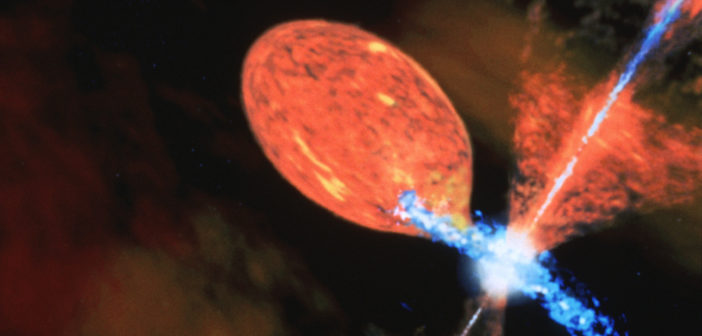“One of the advantages to being disorganized is that one is always having surprising discoveries.”
—A.A. Milne
So begins a recent publication exploring the mystery of CN Cha, an unexpected discovery found in the “disorganization” of vast archives of data. What did we find, and how can we learn from it? The story starts with an unexpectedly luminous star in the Gaia mission’s second data release.
Morphing Appearances

A comparison of two images of CN Cha (red crosshairs), the top taken in April 1991 and the bottom in June 2016. [Adapted from Lancaster et al. 2020]
But when a team of scientists led by Lachlan Lancaster (Princeton University) combed through a recent Gaia catalog looking for interesting bright and distant objects for spectroscopic follow-up, they found a different description of CN Cha: an unusually luminous star that’s not variable.
What followed for Lancaster and collaborators was a detailed dive into decades of archival photometric data — data produced by more than a dozen different observatories and ranging from infrared to ultraviolet wavelengths.
An Eruptive History
By cobbling together this archival data, Lancaster and collaborators were also able to piece together CN Cha’s unusual story.
CN Cha started out with all the properties of a Mira variable star — but then, in 2013, it underwent a spectacular outburst, brightening by about 8 optical magnitudes. For roughly 3 years, it maintained this brightened state, before starting to dim at a rate of 1.4 magnitudes per year.
The authors use this history and new spectroscopic observations to identify the most likely explanation for this mystery: CN Cha is probably a symbiotic binary system that recently experienced a long-duration nova eruption.

Photometry from the ASAS (black), APASS (light-blue) and the ASAS–SN (pink) surveys showing the outburst and 3-year plateau in CN Cha’s optical luminosity. Click to enlarge. [Adapted from Lancaster et al. 2020]
Puzzling Behavior
Symbiotic binaries consist of an evolved star — in the case of CN Cha, presumably a Mira variable — in an orbit with a white dwarf. As mass is transferred onto the white dwarf, it can ignite thermonuclear fusion, causing the system to go into outburst.
The identification of CN Cha as a slow symbiotic nova is intriguing because there are only a few known examples of these outbursts. And though most of CN Cha’s properties are perfectly consistent with those of other slow symbiotic novae, the 3-year extent of its optical brightness plateau is unusually short for this class of transients: one to several decades is more common.
Organizing the Future

The Vera Rubin Observatory, pictured under construction in this image from May 2019, will soon be a new source of large quantities of time-domain survey data. [LSST Project/NSF/AURA]
But what’s more, CN Cha’s story underscores how many discoveries are still hidden in the vast — and rapidly growing — quantities of human-collected astronomical data.
The astronomy community is making strides toward developing better systems and tools that centralize different data archives and make them accessible and searchable. Perhaps as we become more organized, stories like CN Cha’s will become routine rather than surprising.
Citation
“A Mystery in Chamaeleon: Serendipitous Discovery of a Galactic Symbiotic Nova,” Lachlan Lancaster et al 2020 AJ 160 125. doi:10.3847/1538-3881/aba435

